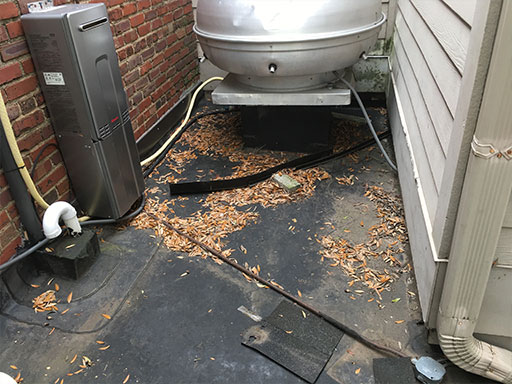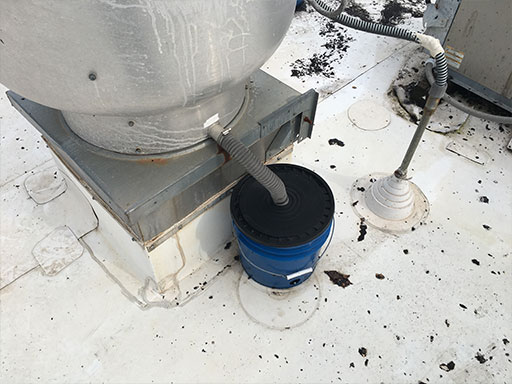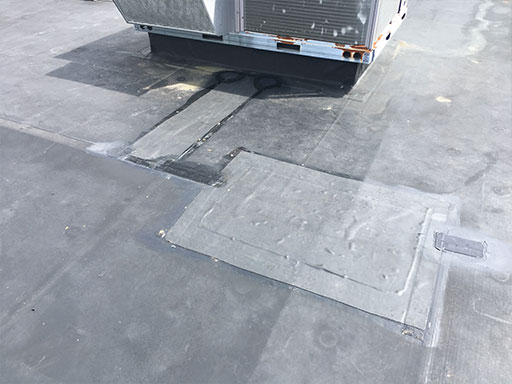Maintaining TPO and EPDM Roof Systems

When it comes to single-ply membranes, two options to choose from are TPO and EPDM. Thermoplastic Polyolefin (TPO) is a modified polypropylene material compounded with fillers that provide high impact resistance and flexibility. Ethylene Propylene Diene Monomer (EPDM) is composed of a synthetic rubber compound that allows for extreme durability and UV Resistance. While both are highly sought after in the commercial and industrial roofing industry, the installation process between the two vary.
To start the installation of a TPO roof system, insulation is first laid down over the prepared substrate. The TPO membrane can then be attached to the insulation using bonding adhesive, mechanical fastening, or ballasting. After the membrane is completely attached, a hot-air welder is used to weld the seams together along the entire roof. Once the roof system is installed, a TPO roof will last approximately 15-20 years. During this time punctures, tears, and degradation can occur due to environmental factors. What exactly can you do to ensure you are getting the most out of your TPO roof system? A great place to start is with routine cleaning using a pressure washer and cleaning solution. This helps keep the surface white to provide maximum reflection for energy conservation, and prevents the collection of dirt, debris, algae, and chemical contaminations that damage the roof’s membrane. After each routine cleaning is performed, the roof should be thoroughly inspected for any incidental damage that has occurred overtime. Inspections are key to proactively identifying damage that can be repaired to improve the longevity of the roof system. Once an area starts to show signs of damage, sheets of TPO are used to weld over the tear or puncture to create a water-tight seal. Roof coatings can also be used as a form of repair, but it is not a preferred method due to low performance. Catching repairs sooner rather than later will lower costs associated with your TPO roof system and ultimately save you money in the long run.
Like the installation of a TPO roof system, an EPDM roof system is installed over insulation and can be fully adhered, mechanically attached, or ballasted. To do so, EPDM sheets are laid out over the insulation (adhered if chosen) and overlapped by adjoining sheets that are spliced with seam tape. Depending on the method that is preferred, the membrane can then be attached mechanically with seam plates and fasteners or ballasted with loose gravel. Unlike TPO, an EPDM roof system does not require an electrical source for heat to seal the seams, allowing for ease of installation. An EPDM roof system lasts approximately 15-20 years after installation. When it comes to environmental factors like hail and rain, EPDM is extremely resistant to punctures and tears due to its rubber composition. However, prolonged exposure to dry and hot temperatures can cause the surface to crack and split as it absorbs the heat. The regular cleaning and maintenance of the EPDM surface will help prevent these tears from happening. To do so, a soft bristled broom should first be used to sweep the surface of the roof. A mild detergent and warm water should be mixed and scrubbed onto the roof with a soft bristle brush or mop. The surface should then be rinsed thoroughly to prevent any build up of residue along the roof system or parapet walls. If defects or damages are noticed, repairs will need to be made. Because the EPDM roof system consists of rubber, it is not compatible with asphalt-based products including some coatings and cement. To repair any damage the area must be cleaned, dried, and primed with a thin coat of EPDM roofing primer. Once the primer starts to become tacky a patch is ready to be installed using seam tape. After the patch is applied and rolled back and forth in multiple directions, all edges must be sealed and flattened onto the surrounding surface. Roof repair patches can continue to be installed onto the EPDM roof system until it is time to be completely replaced.
Be proactive and take the time to regularly clean and inspect your TPO or EPDM roof system to get the most out of it that you can.

Unmaintained EPDM

Unmaintained TPO

